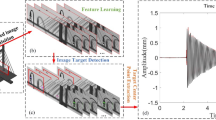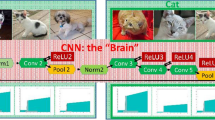Abstract
A novel automatic operational modal analysis method is proposed based on the image recognition of stabilization diagrams with uncertainty quantification. The method not only enriches the contents of the stabilization diagrams to make them much clearer—it can also avoid heavy manual analysis of the stabilization diagrams by automatically obtaining operational modal parameters. In order to increase the efficiency in identifying modal parameters of structures, a traditional stabilization diagram is re-constructed to convey the uncertainty estimates. These stabilization diagrams are then resolved into single mode stabilization diagrams (SMSDs) with a specified frequency interval, for image recognition. Subsequently, a convolutional neural network (CNN) is adopted to automatically analyze the SMSDs. In this study, the CNN is trained by the SMSDs derived from the stabilization diagrams of two numerical examples and three engineering structures. The trained CNN is then validated with a 6 degree-of-freedom model, the Heritage Court Tower building, and the Ting Kau Bridge. The robust learning and prediction results establish that the constructed CNN is effective for analyzing the stabilization diagrams of different structures. It can automatically and accurately identify the physical modes on the stabilization diagrams, without extracting any characteristic parameters.

















Similar content being viewed by others
Explore related subjects
Discover the latest articles, news and stories from top researchers in related subjects.References
ARTeMIS. (2017). Example: Heritage court tower, 1 SVS configuration File and 4 binary measurement files.
Bakir, P. G. (2011). Automation of the stabilization diagrams for subspace based system identification. Expert Systems with Applications, 38, 14390–14397.
Brewer, J. (1978). Kronecker products and matrix calculus in system theory. IEEE Transactions on Circuits and Systems, 25, 772–781.
Brincker, R., & Ventura, C. E. (2015). Introduction to Operational Modal Analysis (pp. 335–346). Chichester: Wiley.
Chauhan, S., & Tcherniak, D. (2009). Clustering approaches to automatic modal parameter estimation. In Conference proceedings of the society for experimental mechanics series.
Deraemaeker, A., Reynders, E., De Roeck, G., et al. (2008). Vibration-based structural health monitoring using output-only measurements under changing environment. Mechanical Systems and Signal Processing, 22, 34–56.
Doebling, S. W., Farrar, C. R., Prime, M. B. et al. (1996). Damage identification and health monitoring of structural and mechanical systems from changes in their vibrational characteristics: A literature review. Technical Report LA-13070-MS, Los Alamos National Laboratory.
Döhler, M., Lam, X., & Mevel, L. (2013). Uncertainty quantification for modal parameters from stochastic subspace identification on multi-setup measurements. Mechanical Systems and Signal Processing, 36, 562–581.
Döhler, M., & Mevel, L. (2013). Efficient multi-order uncertainty computation for stochastic subspace identification. Mechanical Systems and Signal Processing, 38, 346–366.
Goi, Y., & Kim, C. W. (2016). Mode identifiability of a multi-span cable-stayed bridge utilizing stabilization diagram and singular values. Smart Structures and Systems, 17, 391–411.
Golub, G. H., & Van Loan, C. F. (1996). Matrix Computations (3rd ed.). Baltimore: Johns Hopkins University Press.
Hinton, G. E., Osindero, S., & Teh, Y. (2006). A Fast Learning Algorithm for Deep Belief Nets. Neural Computation, 18, 1527–1554.
Hubel, D. H., & Wiesel, T. N. (1962). Receptive fields, binocular interaction and functional architecture in the cat’s visual cortex. The Journal of Physiology, 160, 106–154.
Maeck, J., & De Roeck, G. (2003). Description of Z24 benchmark. Mechanical Systems and Signal Processing, 17, 127–131.
Magalhães, F., Cunha, Á., & Caetano, E. (2009). Online automatic identification of the modal parameters of a long span arch bridge. Mechanical Systems and Signal Processing, 23, 316–329.
Mellinger, P., Döhler, M., & Mevel, L. (2016). Variance estimation of modal parameters from output-only and input/output subspace-based system identification. Journal of Sound and Vibration, 379, 1–27.
Ni, Y. Q. (2017). Benchmark study on modal identifiability.
Ni, Y. Q., Wang, Y. W., & Xia, Y. X. (2015). Investigation of mode identifiability of a cable-stayed bridge: Comparison from ambient vibration responses and from typhoon-induced dynamic responses. Smart Structures and Systems, 15, 447–468.
Pavic, A., Miskovic, Z., & Reynolds, P. (2007). Modal Testing and Finite-Element Model Updating of a Lively Open-Plan Composite Building Floor. Journal of Structural Engineering, 133, 550–558.
Peeters, B., & De Roeck, G. (1999). Reference-based stochastic subspace identification for output-only modal analysis. Mechanical Systems and Signal Processing, 13, 855–878.
Peeters, B., & De Roeck, G. (2001). Stochastic system identification for operational modal analysis: A review. Journal of Dynamic Systems, Measurement and Control, Transactions of the ASME, 123, 659–667.
Peeters, B., Van Der Auweraer, H., Vanhollebeke, F., et al. (2007). Operational modal analysis for estimating the dynamic properties of a stadium structure during a football game. Shock and Vibration, 14, 283–303.
Phillips, A. W., & Allemang, R. J. (2008). Additional mechanisms for providing clear stabilization (consistency) diagrams. In 23rd international conference on noise and vibration engineering (pp. 2661–2693).
Reynders, E., & De Roeck, G. (2010). A local flexibility method for vibration-based damage localization and quantification. Journal of Sound and Vibration, 329, 2367–2383.
Reynders, E., Pintelon, R., & De Roeck, G. (2008). Uncertainty bounds on modal parameters obtained from stochastic subspace identification. Mechanical Systems and Signal Processing, 22, 948–969.
Reynders, E., Teughels, A., & De Roeck, G. (2010). Finite element model updating and structural damage identification using OMAX data. Mechanical Systems and Signal Processing, 24, 1306–1323.
Van der Auweraer, H., & Peeters, B. (2004). Discriminating physical poles from mathematical poles in high order systems: use and automation of the stabilization diagram. In Proceedings of the 21st IEEE instrumentation and measurement technology conference (pp. 2193–2198). IEEE Cat. No. 04CH37510.
Van Overschee, P., & De Moor, B. (1996). Subspace identification for linear systems: Theory, implementation and applications. Springer.
Wen, R. K., & Veletsos, A. S. (1962). Dynamic behavior of simple-span highway bridges. Highway Research Board Bulletin, 315, 1–26.
Zhang, G., Tang, G., & Tang, B. (2012). An improved stochastic subspace identification for operational modal analysis. Measurement, 45, 1246–1256.
Acknowledgements
This study was supported by the National Key R&D Program of China (Grant No. 2017YFC0806100), the National Science Foundation of China. The authors thank all the respectable researchers, particularly Prof. Ni Y. Q. and Prof. Wenzel H., as well as SVS Company, for providing the monitoring data and materials related to HCT, TKB, Z24 Bridge, Canton Tower, and S101 Bridge.
Author information
Authors and Affiliations
Corresponding author
Additional information
Publisher's Note
Springer Nature remains neutral with regard to jurisdictional claims in published maps and institutional affiliations.
Rights and permissions
About this article
Cite this article
Su, L., Zhang, JQ., Huang, X. et al. Automatic operational modal analysis of structures based on image recognition of stabilization diagrams with uncertainty quantification. Multidim Syst Sign Process 32, 335–357 (2021). https://doi.org/10.1007/s11045-020-00741-0
Received:
Revised:
Accepted:
Published:
Issue Date:
DOI: https://doi.org/10.1007/s11045-020-00741-0




